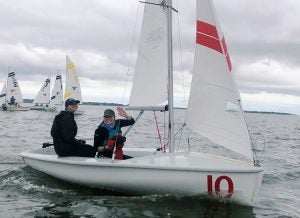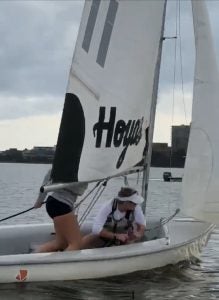Biophysics Major Who Hopes to Help Fight Climate Change Contributes to Interdisciplinary Oceanographic Research
Biological physics major Victoria Boatwright (C’22) has always been fascinated by the ocean. In a recent publication through the Georgetown Scientific Research Journal (GSR), the junior examined how biology and physics interact to affect the ocean, which she hopes will help contribute to climate change research.
An Avid Aquatic Interest

Victoria Boatwright sailing for Georgetown team
Originally from the Narragansett Bay area in RI, Boatwright says that her fascination with the ocean was piqued through her participation in the sailing team at Georgetown.
“I always learned about sailing in terms of how to respond to pressure differentials, why the wind comes in at different times and how the current will affect your sailing speed,” she explains. “I had so many questions that I wanted answered, so once I began taking physics courses, I thought a lot of these processes that I have to respond to when I’m sailing are tangible things that can be quantified and examined through theorems.”
Her curiosity to understand the mechanisms of ocean phenomena led her to do independent research on its significance for climate change as she hopes to engage in climate policy and inform climate solutions. Boatwright sought out collaborative research opportunities, emailing several professors both on and off Georgetown’s campus whose research intersected with her own interests.
Eventually, she got in contact with Baylor Fox-Kemper, a professor of Brown University’s Earth, Environmental, and Planetary Sciences Department, who allowed Boatwright to join in his lab meetings remotely.
“Sitting in on these meetings really helped me focus on areas of research that I could do, and I realized that I could use my background in biological physics from Georgetown to help me navigate earth science-focused materials,” Boatwright says.
In addition to her time in Fox-Kemper’s lab, Boatwright also works with Peter Olmsted, a professor in the Department of Physics who is her advisor and mentor. While his research involves physics at the cellular level, their work overlaps in its applications of fluid dynamics.
Boatwright emphasized the value she has gained from Olmsted’s mentorship in understanding his research perspectives coming from soft matter and microscopic systems.
“It’s really great to see how our research, mine on the ocean and his on cells, has intersected,” Boatwright says. “I think it speaks to how interdisciplinary the scientific community is and how much all of our individual work impacts other areas of study.”
Olmsted says that Boatwright “is voraciously interested in research!”
“The thesis of Victoria’s work with the Brown group, that biological activity can influence local oceanic and climate behavior, is a provocative variation on the well-known effect of life on planetary atmospheres,” the professor says. “She is already starting to develop the important research skill of ‘do whatever it takes to get it done’, and I look forward to seeing what more she unearths as she continues over the next year!”
Research for the Climate

Boatwright participating in Sailing Team
In her research that was published in GSR, Boatwright examines how distributions of phytoplankton, which is an abundant marine plant, and physics impact one another to create local turbulence, such as the eddies that spin off from major ocean circulations or off coasts.
These small-scale interactions can influence other, larger oceanic processes such as heat capacity, global carbon budgets, and higher trophic species abundance. Boatwright’s research is unusual in that it combines two fields of research that are often examined in silos.
“Oceanographers often study either the physics or they study the biology, but I noticed in my research that there were many intersections where physics impacted phytoplankton that in turn was impacting the physics,” the junior says. “Only recently have we developed the resolution and models to actually study that confluence and that two-way coupling.”
Her work in this area has large implications, not only for each scientific discipline but for climate change research. A recipient of the Hollings Scholarship from NOAA, Boatwright plans to continue this work by studying eddies in the California Current and their effects on productivity this summer.
Boatwright intends to complete a senior thesis project in her final year at Georgetown with continued mentorship from Olmsted and Fox-Kemper. After graduation, she hopes to pursue a graduate degree in oceanography or earth sciences. Ultimately, she would like to continue her research or become involved in policy implementation to protect our oceans and mitigate accelerated climate change.
